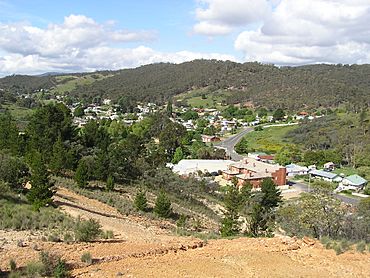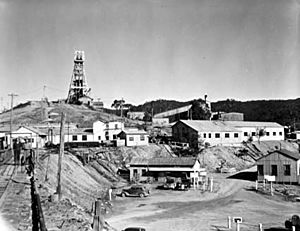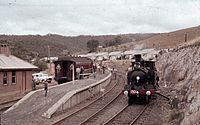Captains Flat facts for kids
Quick facts for kids Captains FlatNew South Wales |
|||||||||||||||
|---|---|---|---|---|---|---|---|---|---|---|---|---|---|---|---|

Captains Flat from Mine Hill
|
|||||||||||||||
| Established | 1883 | ||||||||||||||
| Postcode(s) | 2623 | ||||||||||||||
| Elevation | 852 m (2,795 ft) | ||||||||||||||
| Location |
|
||||||||||||||
| LGA(s) | Queanbeyan-Palerang Regional Council | ||||||||||||||
| County | Murray | ||||||||||||||
| Parish |
|
||||||||||||||
| State electorate(s) | Monaro | ||||||||||||||
| Federal Division(s) | Eden-Monaro | ||||||||||||||
|
|||||||||||||||
Captains Flat is a small town in the Southern Tablelands of New South Wales, Australia. It's located south of Queanbeyan and is part of the Queanbeyan-Palerang Regional Council. This town has a rich history, mainly linked to mining.
Contents
What's in a Name?
The town's name might come from a white bullock (a young bull) named "Captain." This bullock often wandered from Foxlow station, about 12 kilometers away. He liked to graze in the grassy flatlands near the Molonglo River.
A Glimpse into Captains Flat's Past
Before Europeans arrived, the Ngarigo Aboriginal people lived in this area. Captains Flat grew because of mining. People found valuable metals like gold, silver, lead, zinc, copper, and iron pyrites in the hills. These hills are located near the upper parts of the Molonglo River.
The town was very busy from 1881 to 1899. After that, it became much quieter until 1939. At that time, a new railway helped mining start up again. This second mining period lasted for another 23 years.
How Mining Shaped the Town
Copper was first discovered here in 1874. In 1882, the Molonglo goldfield was officially opened. Gold and silver mining began at two mines, Koh-i-noor and Commodore. Two large blast furnaces were built in 1885 to process the ore.
The two mining companies joined together in 1894. They formed the Lake George United Mining and Smelting Company. At first, the mines mostly produced copper, with some silver and a little gold. It was tricky to process the metals because zinc was also present.
Getting the Ore Out
To move the ore, the company built a narrow 610mm (2-foot) tramway in 1897. Small trains with dump cars were pulled by a Krauss steam locomotive. This tramway likely closed around 1902. In the early 1900s, the mine focused on gold and copper. All mining stopped in 1920.
Mining During Wartime
Mining restarted in 1939. During World War II, the Australian government supported the mines. They provided help with power and transport costs. This was because the metals earned money from other countries, which was important for Australia.
In 1940, about 550 people worked at the mine. The town's population grew to 1700. The mining company, Lake George Mines, built 152 fibro cottages for families. They also built a hostel for single workers. Some people even lived in tents. The company also provided a theatre, hospital, tennis courts, and a swimming pool. They paid for medical staff, street lighting, electricity, and water.
In the 1930s and 1940s, many old buildings were replaced. The new hotel, built in 1938, was famous for having a very long bar. It was said to be 32 meters long, one of the longest in Australia at the time!
Miners' Challenges and Strikes
Miners in Captains Flat faced tough working conditions. There were some big worker strikes in the 1940s and 1950s. For example, a strike in 1948-49 and a lockout in 1954-55 both lasted for seven months.
The mine finally closed on March 11, 1962. This happened because there wasn't enough valuable ore left to dig up. By then, miners had worked in tunnels that went 840 meters (2,800 feet) underground.
From 1939 to 1962, over 4 million tonnes of ore were dug up. This produced 1.5 million tonnes of concentrated metals. These included 39% zinc, 33% pyrites, 24% lead, and 5% copper. Small amounts of gold (2850 tonnes) and silver (155 tonnes) were also found. After the mine closed, the company sold off its buildings and equipment. Many of the cottages were even removed.
The Captains Flat railway line from Bungendore opened in 1940. Trains ran three times a week. After the mine closed, this was reduced to once a week. The railway officially stopped operating on August 31, 1968. However, it reopened for a few weeks in 1969 for the movie "Ned Kelly" to be filmed.
Environmental Impact of Mining
The mining process created sulphur and acid rain. This has made the land around the old mines look very different. It's a bit like the landscape in Queenstown, Tasmania.
In 1939 and 1942, waste from the mine, called tailings, spilled into the Molonglo River. This pollution badly harmed the plants and animals in the river. All the native fish living downstream from the mine disappeared.
Cleaning Up the River
In 1976, the government spent $2.5 million to clean up the area. Even with these efforts, harmful substances still enter the river from the mine site. The cleanup involved covering the waste piles with clay and plants. This was done to stop them from collapsing again. The mining company was not made to pay for this environmental damage. A long part of the Molonglo River still doesn't have native fish.
Today, people are looking for new minerals in the area again. Companies like Ironbark Gold are exploring.
Recent Soil Testing
In February 2021, the NSW Environment Protection Authority (EPA) tested the soil in public areas. They found some places with higher levels of lead. These included "Foxlow Parklet" and the [Captains Flat Community Preschool].
When the preschool learned about these results, they quickly took steps to keep the children safe. The preschool closed for one week for a thorough cleaning. The outdoor playground was closed, and children had to take their shoes off inside. The preschool is on government land, and the government department will handle any future cleanup. Meanwhile, the preschool continues to operate safely with these new rules. The school had to be moved to the oval near Captains Flat Public School.
Weather Watch
Captains Flat is home to the main weather radar for the ACT and southern NSW. It's a WSR-74S radar operated by the Bureau of Meteorology. It sits on a 22.35-meter tower on Mt Cowangerong.
Famous Faces from Captains Flat
- Mark Gable (born 1950 in Captains Flat) is an Australian musician. He is the lead singer and a founding member of the rock band The Choirboys.
- Ivy Weber (1892–1976) was the first woman elected at a general election in Victoria, Australia. She was also the first woman in Australia to win a seat as an independent politician.
- Tom Wills (1835–1880) was Australia's first great cricketer. He also helped create Australian rules football.






